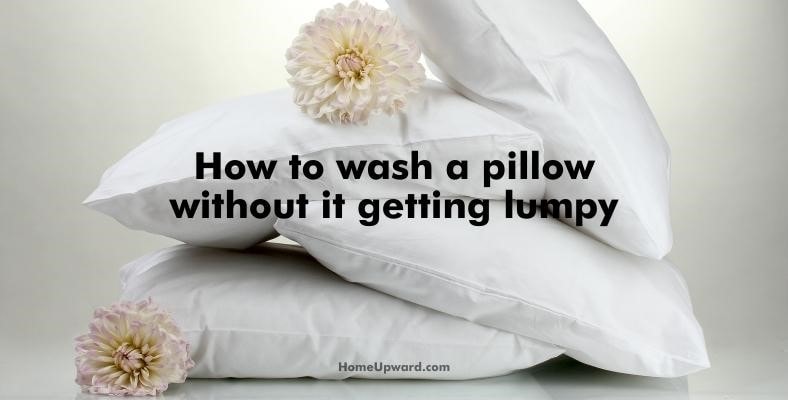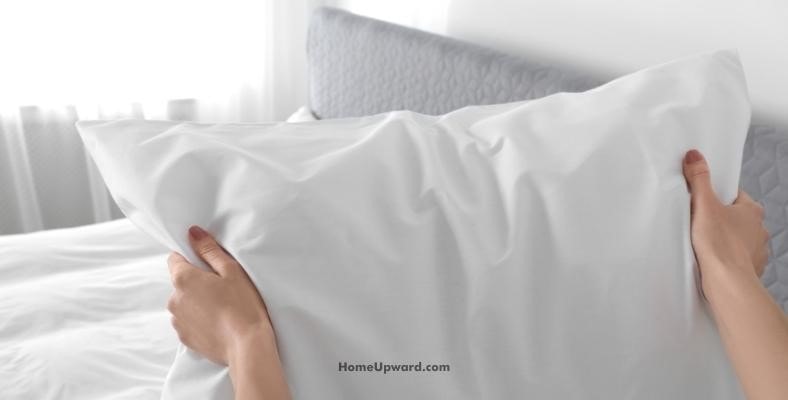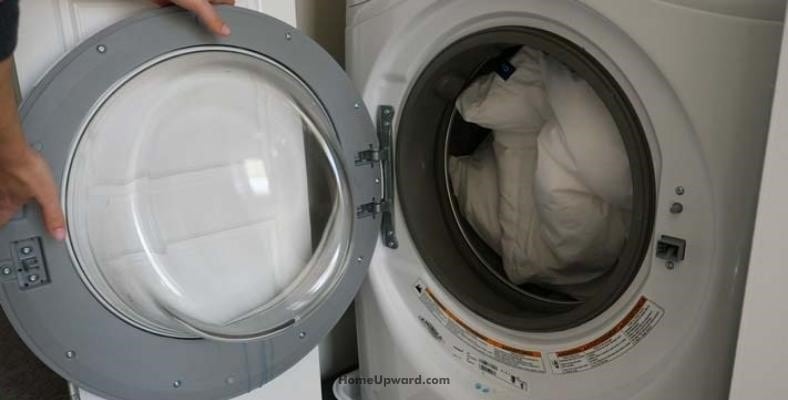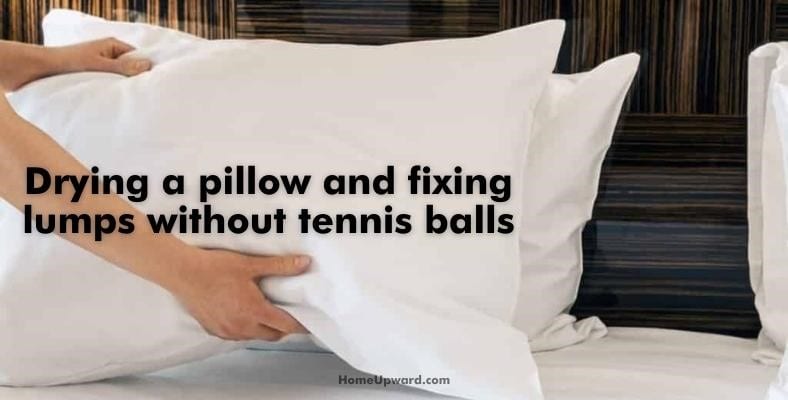Need to know how to wash a pillow without it getting lumpy? Read on to learn how!
Contents
How to Wash a Pillow Without It Getting Lumpy
It’s pretty simple, and you can do it at home without any special equipment besides a washer and dryer, so there’s no excuse for having smelly, oily, unwashed pillows.
How you set up your laundry in the machine is part of how to wash a pillow without it getting lumpy. Regardless of whether you’re washing feather pillows or synthetic pillows, make sure that you load two pillows into the washer, never just one.
This will help prevent them from getting tossed around too much and will minimize the risk of lumpiness.
Can You Machine Wash Most Pillows?
Most pillows have care instructions sewn to them so you should be able to see if machine washing will work. The ones that are most likely machine washable include:
- Feather pillow
- Microfiber or synthetic pillow
- Polyester pillow
Typically, the following types of pillows can’t go in the machine washer:
- Memory foam pillow or other foam pillows
- Gel pillows
- Buckwheat hull pillows
- Any pillow with a care label that says it’s not machine washable
You might also run into trouble if you use a large body pillow. When machine washing, pillow size can be an issue if it’s too big or too small for the machine.
Even if you can’t wash your pillow in the machine, you can keep it clean with one really easy trick: use a pillow protector underneath your pillowcase for another protective barrier under your regular pillowcase.
You also want to wash your pillowcase every so often to prevent bacteria from building up near your face where you sleep.
Which Wash Cycle is Best for Machine Washing a Pillow?
The best washing cycle for preventing a lumpy pillow is the gentlest one your machine can perform.
Skip the fabric softener, and use cold or warm water, not hot. You should also use the mildest detergent you have.
Why Do Pillows Get Lumpy After Washing?
Pillows can get lumpy after washing because the fill material that keeps them fluffy gets clumped when they’re not laundered properly. That’s why it’s essential to follow some washing machine tips to prevent this.
Washing Machine Tips to Prevent Lumpy Pillow Problems
The best way to prevent lumpy pillow problems is to follow a few simple tips.
- Never wash a pillow by itself. Wash two pillows together, and consider adding some towels to balance the load and prevent things from moving around too much.
- Use the gentlest washing cycle your machine has.
- Use a small quantity of a mild detergent, and consider using a washing powder instead of a liquid detergent.
- Never use fabric softeners on pillows.
- Use an extra rinse cycle.
- Never machine wash a foam pillow or a gel pillow.
You can also add ½ a cup of vinegar to your washer when washing a pillow. Vinegar acts as both a natural fabric softener and a mild germ killer.
Plus, it will help eliminate any foul odors. If you have a favorite essential oil smell, add a drop or two to the vinegar to add a bit of a pleasing scent to your pillows. Vinegar is also handy for cleaning a mattress without baking soda.
How Do You Unclump a Pillow?
To unclump a pillow, you’re going to need a lot of fresh air and fluffing. Ideally, bring your pillows outside and clip them to a clothesline.
Let them dry in the breeze for an hour or two. Then, fluff them by hand, gently moving the filling material around.
After that, clip them back up for another couple of hours and fluff them again. They should be much less clumpy, but you can repeat this if needed until they’re completely dry and back to their fully-fluffed selves.
How To Dry Pillows Without Clumping Them
Drying pillows can make them clumpy, just like washing machines. To avoid clumpiness, make sure you’re using the lowest drying temperature on your machine.
High heat can damage the fibers inside your pillow, causing clumpiness and potentially ruining them.
If your machine has an air-dry setting, try using that instead of the heat cycle. It’s better for them, but it will take longer to dry. There are also some products you can buy called dryer balls that help reduce clumpiness in the dryer.
Or you can just throw in a couple of clean tennis balls, as they do the same thing by massaging the pillows a bit as they toss and turn in the dryer. If you have the time, the best way to avoid the risks of your pillows getting clumpy in the dryer is to skip the machine altogether.
Instead, let them air dry and fluff them repeatedly to make sure all the fill gets a chance to dry thoroughly. This drying method takes the longest, but it is the least likely to cause clumpiness.
Can You Wash Pillows in a Top-Loading or Side-Loading Machine?
You can wash pillows in either a top-loading or side-loading washing machine. However, a front-loading machine is best.
Top-loading machines have an agitating column in the middle, which can beat up the pillows and potentially damage their liners. If you have a front-loading machine, simply select the gentlest cycle and the coldest temperature water. Wash two pillows at once, and add a towel or two if there is still a lot of room.
Don’t use fabric softener. You can also consider adding vinegar and a drop or two of essential oils.
You’ll want to take all the same steps with a top-loader. However, fill the machine with water first, and let the cycle start before you open the lid and add your two pillows.
Add a couple of towels or even a sheet to cushion the pillows from the drum and the agitator.
If you have a high-efficiency machine without a central agitator or that you can’t prefill, that’s fine. Just make sure to add plenty of padding and choose the gentlest cycle, so your pillows don’t get beaten up too much.
Drying a Pillow and Fixing Lumps Without Tennis Balls
If you don’t have any tennis balls and you’re afraid of turning your pillows lumpy the best way to dry your pillows is naturally. Instead of using the machine, hang them up outside.
You’ll have to fluff them a lot to make sure they dry thoroughly. The only downside to this method is that it can take a long time. For large bed pillows it may take two full days for them to dry completely.
How Often Should You Wash Your Pillow?
Routinely cleaning your home is essential for staying healthy. Even though it’s a bit of a hassle, it’s also a good idea to clean your pillows regularly.
An ideal rule of thumb is that you should clean your pillows three to five times per year if you use them every night.
Each night when we’re sleeping, we shed skin cells and leave body oil on our pillows. Allergens, like dust mites, may even accumulate without enough cleaning.







